6. Types of Remanence
A rock carries a natural remanent magnetization (NRM) that is the vector sum of all the different possible components of magnetization acquired over its history. SD, PSD, and MD grains may all contribute to this signal. After initially acquiring a primary magnetization, grains with low relaxation times may be susceptible to remagnetization by time, temperature or chemical changes and produce secondary components of magnetization.
There are many different ways for a particle to become magnetized. The most common ones are:
| Remanence | Acronym | Magnetization Process |
|---|---|---|
| Thermoremanent Magnetization | TRM | Magnetization acquired during cooling from a temperature above the Curie Temperature in an external field |
| Chemical Remanent Magnetization | CRM | Magnetization acquired during chemical changes in an external field |
| Viscous Remanent Magnetization | VRM | Magnetization acquired over time in an external field |
| Isothermal Remanent Magnetization | IRM | Magnetization acquired instantaneously in an external field |
| Anhysteretic Remanent Magnetization | ARM | Magnetization acquired by the combined effects of a large alternating field and a small DC field |
| Depositional Remanent Magnetization | DRM | Magnetization acquired by sediments when grains settle out of water in an external field |
| Post Depositional Remanent Magnetization | pDRM | Magnetization acquired after depositon due to mechanical effects in wet sediment |
TRM
The energy levels of the (+) and (-) states of SD particles split in the presence of a external field producing an asymmetrical energy barrier. Moments parallel to the field have a lower energy than moments in the opposite direction. As a consequence, the number of particles in the field direction will be greater than the number in the opposite direction. This results in a net moment in the field direction.

Just above the blocking temperature, TB, the energy barrier is small and a weak-field can produce a net alignment of grain moments parallel to the external field. On cooling below TB, the energy barrier becomes so large that the net alignment is preserved.
At room temperature, the energy barrier is now much higher. An external field equal to the coercivity is needed to reverse the magnetization. A weak-field, like the earth's field, which induced the TRM at high temperature has little effect on the magnetization at room temperature. The relaxation time is very long and hence the TRM is essentially stable on a geological time scale.
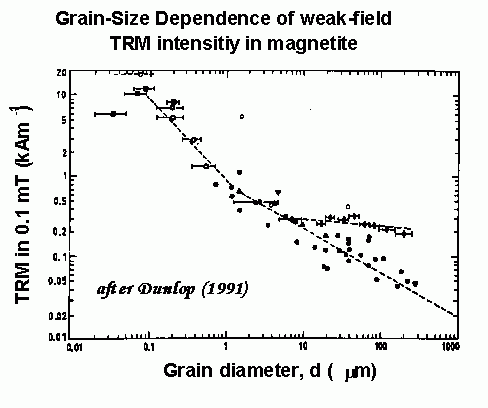
The intensity of a weak-field TRM is linear in applied field (h<1 mT) and it is grain-size dependent:
CRM
Any type of chemical alteration may induce a magnetization:
- low-temperature oxidation
- exsolution
- diagenesis
- dehydration
There are two main types of CRM:
- pure growth CRM from the growth of new minerals through a critical volume
- recrystallization CRM from the recrystallization or alteration of pre-existing mineral grains.
The acquisition of CRM in (1) is similar to the process of TRM, but instead of talking about a blocking temperature, we have a blocking volume. In this case, grains grow from the superparamagnetic to the stable single domain size.
The acquisition of CRM in (2) is a more complex process because the new recrystallized phase can be influenced by the parent phase as well as the external field.
IRM
Isothermal remanent magnetization is the remanence left in the sample after a steady field (1-1000 mT) has been applied for a short time (100 sec) and then switched off.
For magnetite, in fields below approximately 50 mT, IRM is produced by irreversible domain wall translation. In fields above approximately 50 mT, IRM is produced by irreversible domain rotation in MD grains or moment rotation in SD grains.
There are three techniques used to characterize IRM:
- Acquisition measured by applying incrementally increasing fields to initially demagnetized samples. The maximum remanence is the saturation remanence.
- DC demagnetization measured by applying incrementally increasing negative DC fields to an SIRM. The field required to reduce the SIRM to zero is the coercivity or remanence (Hr).
- AF demagnetization measured by applying incrementally increasing alternating fields to an SIRM
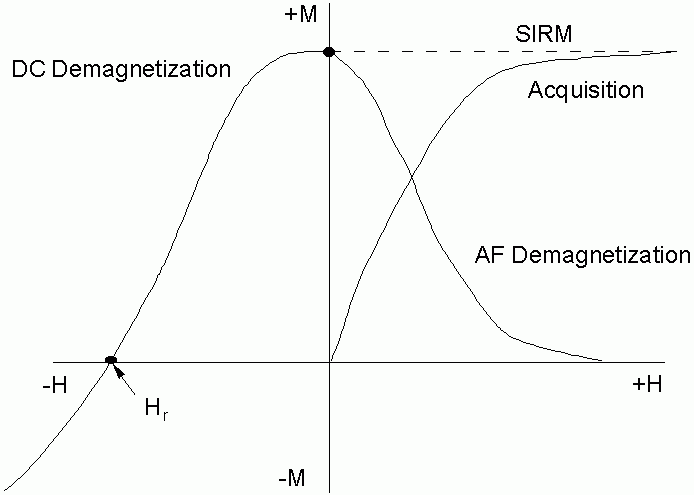
IRM acquisition is a useful technique to distinguish between magnetite and hematite.

Coercivity in hematite is usually much larger than that observed in magnetite. Hence, during IRM acquisition, it is more difficult to saturate hematite than magnetite. Magnetite is typically saturated by 300-500 mT.
IRM acquisition and demagnetization curves are also useful for studying the effects of interactions between magnetic particles.
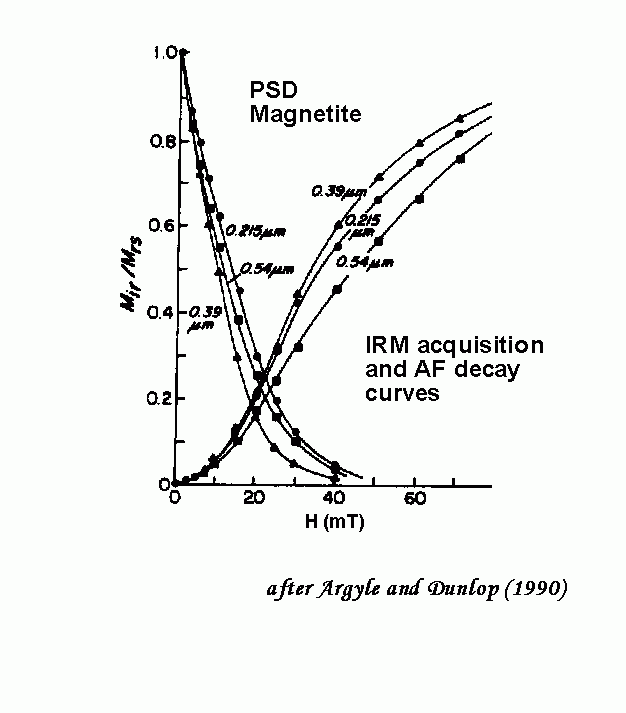
Non-interacting SD grains produce symmetrical curves.
Interacting SD or MD grains produce asymmetrical curves.
ARM
Anhysteretic remanent magnetization is produced by the combined actions of a large AF and a smaller constant DC field. An ARM is imparted by slowly reducing a peak AF to zero while at the same time applying a constant DC field. ARM is a useful laboratory technique for characterizing magnetic particles.
The intensity of ARM for weak-fields (< 10 mT) is always much larger than a comparable IRM given in the same DC field.
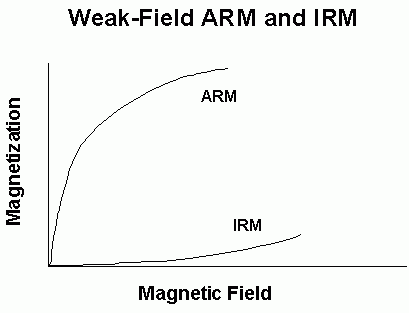
During ARM acquisition, the DC field is assisted by the AF in the acquisition process. Likewise, the remanence coercivity fractions activated by the ARM and IRM processes will also be dissimilar.
There is a similarity between ARM and TRM. The randomizing effects of the AF for ARM plays a similar role to the randomizing effects of temperature for TRM. Because of this similarity, ARM has been used as an analogue for TRM.
Like TRM, the intensity of ARM is linear with applied DC field for fields less than about 1 mT. The slope of this line is referred to as the ARM susceptibility.
AF Demagnetization Curves
Comparison of AF demagnetization curves of a weak-field ARM (or TRM) and a strong-field IRM has some diagnostic capability and is called the Lowrie-Fuller test. This test discriminates between SD/PSD and MD particles.
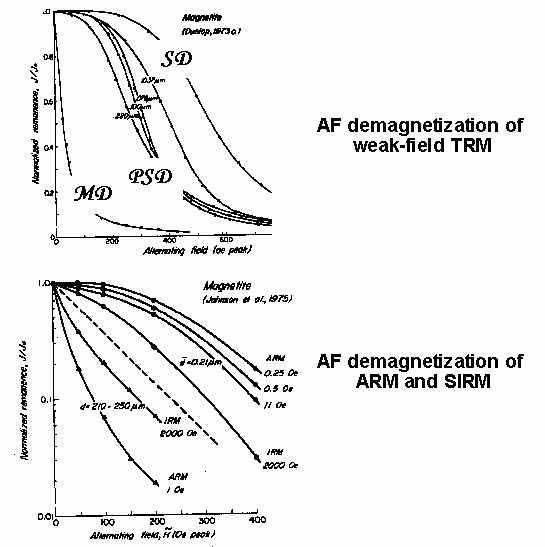
| SD/PSD | MDFARM > MDFSIRM |
| MD | MDFARM < DFSIRM |
The grain size resolution is not that great. In magnetite the threshold size between SD/PSD type curves and MD type curves is a few microns. This test can simply establish whether a particular average grain size is larger or smaller than this threshold size.